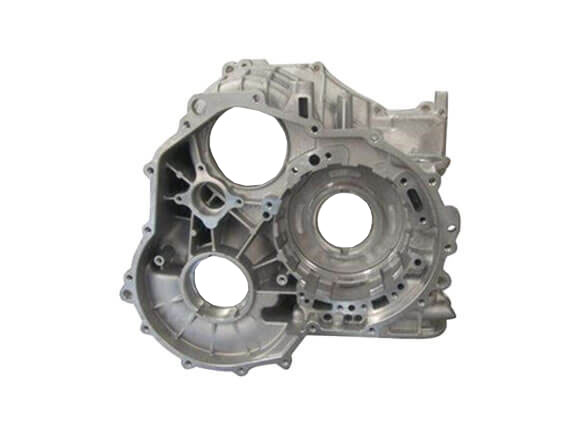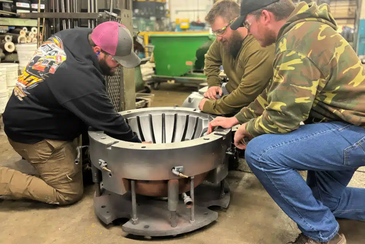The importance of aluminum casting in creating lightweight metal parts
Wiki Article
Exploring the Innovative Procedures Behind Modern Light Weight Aluminum Factory Workflow
Modern aluminum shop procedures are undertaking considerable improvement. Automation and AI are reshaping manufacturing approaches, improving both performance and accuracy. The assimilation of 3D printing is improving mold creation, while sustainability techniques are becoming a lot more important. Each of these innovations plays an essential role in redefining the industry. Nonetheless, the effects of these changes extend past mere manufacturing effectiveness. What opportunities and obstacles lie ahead for light weight aluminum foundries in this developing landscape?The Function of Automation in Aluminum Foundries

In addition, automation adds to improved safety criteria within the foundry atmosphere. By transferring harmful tasks to devices, human employees can focus on supervisory functions and quality assurance, reducing the threat of crashes. Additionally, data analytics stemmed from automated processes provide valuable insights right into functional performance, causing much better decision-making and continuous improvement. As the demand for light weight aluminum products expands, the adoption of automation modern technologies will likely broaden, better transforming the landscape of aluminum foundry procedures.
Innovations in Casting Technologies
Recent advancements in casting innovations are changing light weight aluminum foundry procedures. Technologies such as 3D printing assimilation, progressed alloy formulas, and automated process optimization are enhancing effectiveness and product top quality. These advancements are pivotal in fulfilling the developing needs of the industry.3D Printing Combination
Incorporating 3D printing modern technology right into light weight aluminum shop operations has actually changed typical spreading approaches, improving both effectiveness and precision. This innovative technique permits the quick manufacturing of complex mold and mildews and cores, substantially decreasing preparations and product waste. By making use of additive production, factories can create detailed geometries that were previously challenging or impossible to accomplish with conventional techniques. The versatility of 3D printing additionally allows quick style alterations, promoting a much more active manufacturing procedure. In addition, this combination sustains the use of light-weight frameworks, which is progressively crucial in industries such as auto and aerospace. As aluminum factories remain to embrace 3D printing, they place themselves at the center of technical development, driving improvements in product top quality and operational capacities.Advanced Alloy Formulations
The development of innovative alloy formulations has significantly boosted casting innovations in light weight aluminum foundry procedures. These formulations incorporate numerous elements, such as silicon, copper, and magnesium, to enhance mechanical residential properties and thermal resistance. By customizing the make-up of aluminum alloys, makers can accomplish certain efficiency attributes that meet the needs of varied applications, from auto elements to aerospace frameworks. Making use of sophisticated alloys also adds to lowered weight and increased strength, which are important consider modern-day engineering. In addition, technologies in alloy growth allow much better fluidity throughout casting, leading to improved surface coatings and minimized defects. Overall, progressed alloy formulas represent a substantial leap forward, positioning light weight aluminum shops to fulfill the evolving demands of various markets efficiently.Automated Process Optimization
Developments in casting technologies have led the means for automatic process improvement in aluminum factory procedures. By incorporating innovative software program and real-time data analytics, shops can now streamline production processes and improve top quality control. Automated systems monitor variables such as cooling, temperature level, and stress prices, enabling immediate modifications that minimize issues and waste. Furthermore, maker learning algorithms evaluate historical performance data to anticipate suitable setups, thus boosting efficiency and decreasing cycle times. Robotics additionally play a considerable function, managing repeated jobs that enhance safety and accuracy. In general, these innovations not only drive operational efficiency but additionally enable shops to satisfy the growing need for high-grade light weight aluminum parts in various sectors.Smart Production and Industry 4.0 Combination
The integration of Smart Production and Market 4.0 within light weight aluminum shops is changing functional efficiency. By leveraging IoT innovations, automation, and robotics, factories can optimize manufacturing processes and minimize downtime. Additionally, data analytics provides essential understandings that enhance decision-making and drive continuous enhancement.IoT in Foundry Procedures
As producers increasingly embrace the Web of Things (IoT), foundry operations are experiencing a transformative shift towards wise production and Sector 4.0 integration. Aluminum Foundry. IoT innovations enable real-time information collection and evaluation, enhancing decision-making processes and functional performance. Sensing units and connected gadgets check devices performance, product usage, and environmental problems, allowing for positive upkeep and source optimization. This connectivity cultivates a more info much more agile production environment, where modifications can be made swiftly in reaction to market needs. In addition, IoT facilitates improved traceability and quality assurance, as data from the entire production cycle can be easily accessed and analyzed. On the whole, the combination of IoT in factory procedures considerably boosts productivity and drives technology in aluminum manufacturing proceduresAutomation and Robotics Assimilation
Automation and robotics integration is reinventing light weight aluminum factory procedures by enhancing efficiency and accuracy. This transformative technique streamlines procedures such as molding, putting, and ending up, minimizing human error and increasing outcome uniformity. By utilizing innovative robotic systems, factories can achieve higher production rates while maintaining rigid high quality criteria. Automated systems additionally make it possible for real-time tracking and flexible control, permitting speedy modifications to production parameters. In enhancement, the assimilation of robotics reduces labor costs and minimizes safety risks connected with hands-on handling of molten metal. As foundries embrace clever manufacturing concepts integral in Sector 4.0, the harmony between automation and robotics solidifies their affordable edge, leading the way for sustainable development and development in the light weight aluminum casting industry.Data Analytics for Effectiveness
Utilizing data analytics significantly improves efficiency within light weight aluminum shop procedures, lining up with clever manufacturing and Sector 4.0 principles. By leveraging real-time information collection and evaluation, shops can keep track of manufacturing procedures, anticipate devices failings, and optimize source appropriation. This data-driven approach assists in informative decision-making, allowing managers to improve and recognize bottlenecks workflow. Furthermore, anticipating analytics equips shops to prepare for market needs, thereby minimizing waste and guaranteeing timely product distribution. Combination of information analytics with IoT tools enhances operational visibility, cultivating a proactive upkeep society. Ultimately, implementing these innovative analytical strategies not just enhances efficiency however likewise drives technology, positioning aluminum factories to fulfill the progressing demands of the industry while maintaining competitive edges in a rapidly altering landscape.Lasting Practices in Aluminum Spreading
While the light weight aluminum casting industry has typically dealt with environmental difficulties, several foundries are now embracing sustainable practices to minimize their influence (Precision aluminum casting). A significant focus has gotten on reusing light weight aluminum scrap, which not only decreases waste but also preserves energy compared to key aluminum manufacturing. Innovative melting modern technologies, such as induction heating systems, enhance energy performance and reduced greenhouse gas dischargesFurthermore, foundries are applying closed-loop water systems to decrease water intake and decrease thermal contamination. The use of environmentally friendly binders in mold-making processes is acquiring traction, more reducing dangerous emissions.
Some centers are investing in sustainable energy resources to power procedures, lining up with global sustainability goals. By integrating these techniques, the aluminum spreading industry is advancing towards an extra eco accountable future, showing that financial development can exist side-by-side with environmental stewardship - Precision aluminum casting. These efforts mirror a commitment to sustainability and the significance of ecological responsibility in manufacturing
Quality Control Innovations
As the light weight aluminum spreading industry advances in the direction of sustainability, the importance of top quality control innovations becomes significantly apparent. Modern light weight aluminum factories are adopting sophisticated modern technologies to boost their quality control procedures. Techniques such as real-time surveillance and data analytics allow suppliers to detect problems and disparities early in the production cycle. Applying automatic evaluation systems furnished with maker learning formulas warranties that products satisfy rigid high quality criteria while minimizing human error.The combination of non-destructive testing approaches, such as radiographic and ultrasonic examinations, provides deeper understandings right into the integrity of castings without harming the material. These technologies not just enhance item dependability however likewise minimize waste, lining up with sustainability goals. In enhancement, the adoption of standard quality frameworks helps enhance procedures throughout different factories, guaranteeing uniformity in result. Jointly, these improvements are improving quality control, promoting a society of excellence within the aluminum spreading industry.
Future Patterns in Light Weight Aluminum Factory Operations
What innovations exist ahead for aluminum shop operations? The future of aluminum factories is poised for change with innovations in automation, fabricated intelligence, and sustainable methods. The assimilation of robotics and automated systems is anticipated to boost performance and accuracy in the casting processes, lowering human error and labor expenses. In addition, AI-driven analytics will allow real-time surveillance and predictive maintenance, maximizing operational performance and decreasing downtime.Sustainability remains a focal point, with foundries increasingly taking on environment-friendly methods, such as utilizing recycled aluminum and developing low-emission melting modern technologies. Advancements in 3D printing are also anticipated to reinvent mold-making, enabling intricate geometries and reduced material waste. As the sector embraces digitalization, data-driven decision-making will certainly come to be pivotal, allowing foundries to react quickly to market needs. Jointly, these fads assure to redefine light weight aluminum factory operations, making them a lot more efficient, lasting, and adaptable to future difficulties.

Often Asked Questions
What Precaution Are Applied in Aluminum Foundry Workflow?
Aluminum shop procedures implement various precaution, including individual safety devices, air flow systems to manage fumes, regular security training, emergency situation response strategies, and rigorous monitoring of temperature level and tools to avoid crashes and assurance worker security.Just How Do Foundries Take Care Of Workforce Educating for New Technologies?

What Products Are Typically Reused in Light Weight Aluminum Foundries?
Aluminum foundries generally reuse scrap light weight aluminum, consisting of post-consumer items like beverage containers, automotive components, and construction products. This recycling process decreases waste and conserves sources, adding to an extra sustainable aluminum manufacturing market.Just How Does Aluminum Casting Effect the Atmosphere?
Aluminum casting impacts the atmosphere with energy-intensive procedures, greenhouse gas discharges, and potential local pollution. Innovations in recycling and lasting methods can alleviate these results, promoting a more environmentally friendly technique to light weight aluminum manufacturing.What Are the Common Lead Times for Light Weight Aluminum Casting Projects?
Normal preparation for aluminum casting projects differ significantly, normally varying from two to six weeks. Variables influencing these timelines include intricacy, order dimension, and product availability, affecting overall manufacturing schedules in foundry operations.
Automation significantly plays an essential function in light weight aluminum shops, enhancing performance and accuracy in the manufacturing procedure. Developments in casting innovations have actually paved the means for automatic procedure improvement in aluminum foundry operations. Utilizing data analytics significantly improves performance within aluminum foundry operations, straightening with clever production and Industry 4.0 concepts. A significant emphasis has actually been on recycling light weight aluminum scrap, which not just reduces waste however also saves power compared to primary light weight aluminum production. Light weight aluminum foundries generally recycle scrap aluminum, consisting of post-consumer items like beverage cans, auto parts, and building and construction products.
Report this wiki page